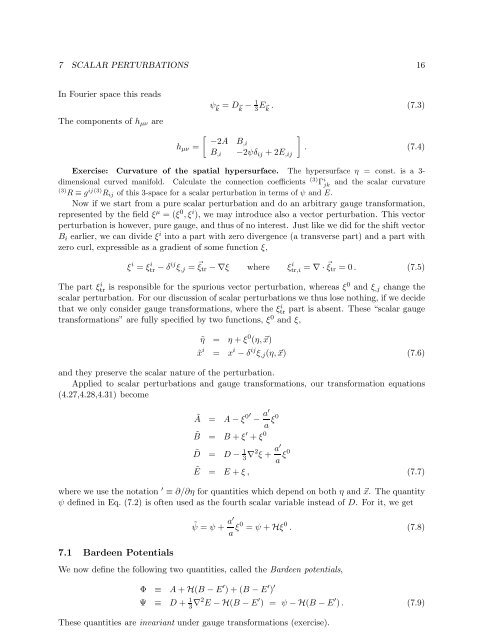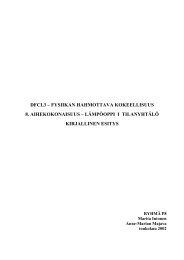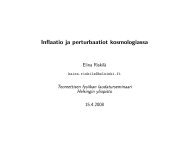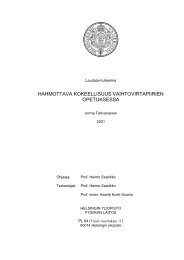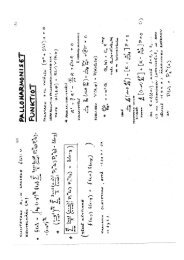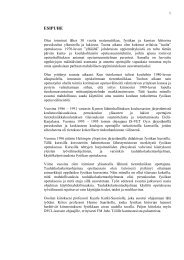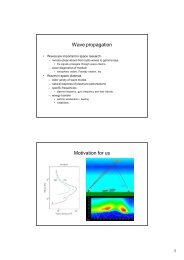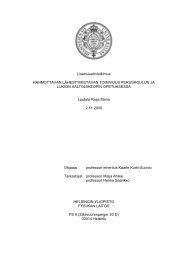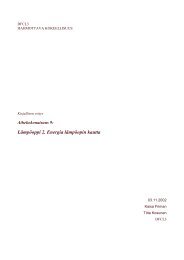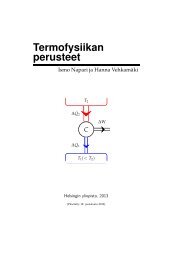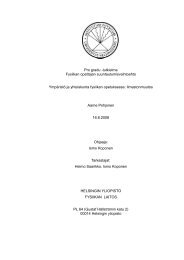Cosmological Perturbation Theory, 26.4.2011 version
Cosmological Perturbation Theory, 26.4.2011 version
Cosmological Perturbation Theory, 26.4.2011 version
You also want an ePaper? Increase the reach of your titles
YUMPU automatically turns print PDFs into web optimized ePapers that Google loves.
7 SCALAR PERTURBATIONS 16In Fourier space this readsThe components of h µν areh µν =ψ ⃗k = D ⃗k − 1 3 E ⃗ k. (7.3)[ −2A B,iB ,i −2ψδ ij + 2E ,ij]. (7.4)Exercise: Curvature of the spatial hypersurface. The hypersurface η = const. is a 3-dimensional curved manifold. Calculate the connection coefficients (3) Γ i jkand the scalar curvature(3) R ≡ g ij(3) R ij of this 3-space for a scalar perturbation in terms of ψ and E.Now if we start from a pure scalar perturbation and do an arbitrary gauge transformation,represented by the field ξ µ = (ξ 0 ,ξ i ), we may introduce also a vector perturbation. This vectorperturbation is however, pure gauge, and thus of no interest. Just like we did for the shift vectorB i earlier, we can divide ξ i into a part with zero divergence (a transverse part) and a part withzero curl, expressible as a gradient of some function ξ,ξ i = ξ i tr − δij ξ ,j = ⃗ ξ tr − ∇ξ where ξ i tr,i = ∇ · ⃗ξ tr = 0. (7.5)The part ξtr i is responsible for the spurious vector perturbation, whereas ξ0 and ξ ,j change thescalar perturbation. For our discussion of scalar perturbations we thus lose nothing, if we decidethat we only consider gauge transformations, where the ξtr i part is absent. These “scalar gaugetransformations” are fully specified by two functions, ξ 0 and ξ,˜η = η + ξ 0 (η,⃗x)˜x i = x i − δ ij ξ ,j (η,⃗x) (7.6)and they preserve the scalar nature of the perturbation.Applied to scalar perturbations and gauge transformations, our transformation equations(4.27,4.28,4.31) becomeà = A − ξ 0 ′ a ′−a ξ0˜B = B + ξ ′ + ξ 0˜D = D − 1 3 ∇2 ξ + a′a ξ0Ẽ = E + ξ , (7.7)where we use the notation ′ ≡ ∂/∂η for quantities which depend on both η and ⃗x. The quantityψ defined in Eq. (7.2) is often used as the fourth scalar variable instead of D. For it, we get7.1 Bardeen Potentials˜ψ = ψ + a′a ξ0 = ψ + Hξ 0 . (7.8)We now define the following two quantities, called the Bardeen potentials,Φ ≡ A + H(B − E ′ ) + (B − E ′ ) ′Ψ ≡ D + 1 3 ∇2 E − H(B − E ′ ) = ψ − H(B − E ′ ). (7.9)These quantities are invariant under gauge transformations (exercise).


